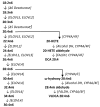Endogenous Anti-Inflammatory Very-Long-Chain Dicarboxylic Acids: Potential Chemopreventive Lipids
- PMID: 30400281
- PMCID: PMC6315409
- DOI: 10.3390/metabo8040076
Endogenous Anti-Inflammatory Very-Long-Chain Dicarboxylic Acids: Potential Chemopreventive Lipids
Abstract
In a paradigm shift, cancer research efforts are being dedicated to the discovery of chemopreventive agents. The goal of this approach is to delay or prevent the progression of augmented cell division to established cancer. Research has focused on dietary supplements, drugs, and endogenous lipids that possess anti-inflammatory properties. We undertook a lipidomics analysis of potential endogenous anti-inflammatory/anti-proliferative lipids in human plasma. We performed high-resolution mass spectrometric lipidomics analyses of plasma samples from controls and patients with colorectal, kidney, pancreatic, glioblastoma, and breast cancers. We present evidence that endogenous very-long-chain dicarboxylic acids (VLCDCA) are anti-inflammatory lipids that possess chemopreventative properties. In a family of VLCDCAs, we characterized VLCDCA 28:4, which is decreased in the plasma of patients with colorectal, kidney, and pancreatic cancers. The structure of this biomarker was validated by derivatization strategies, synthesis of the analytical standard, and tandem mass spectrometry. Our data suggest that VLCDCA 28:4 may be a useful blood biomarker for a number of cancers and that resupplying this lipid, via a prodrug for example, may offer a new anti-inflammatory therapeutic strategy for delaying or preventing the progression of cancer and other inflammatory diseases.
Keywords: anti-inflammatory; cancer; chemoprevention; very-long-chain dicarboxylic acids.
Conflict of interest statement
PLW and LMU have filed a patent regarding VLCDCAs as potential biomarkers for cancer risk and for the utility of analogs/prodrugs as anti-inflammatory and chemopreventive agents.
Figures



Similar articles
-
Reduced Plasma Levels of Very-Long-Chain Dicarboxylic Acid 28:4 in Italian and Brazilian Colorectal Cancer Patient Cohorts.Metabolites. 2018 Dec 6;8(4):91. doi: 10.3390/metabo8040091. Metabolites. 2018. PMID: 30563293 Free PMC article.
-
Potential of Anti-inflammatory Molecules in the Chemoprevention of Breast Cancer.Recent Adv Inflamm Allergy Drug Discov. 2022;16(2):60-76. doi: 10.2174/2772270816666220829090716. Recent Adv Inflamm Allergy Drug Discov. 2022. PMID: 36043708 Review.
-
Enabling High Structural Specificity to Lipidomics by Coupling Photochemical Derivatization with Tandem Mass Spectrometry.Acc Chem Res. 2021 Oct 19;54(20):3873-3882. doi: 10.1021/acs.accounts.1c00419. Epub 2021 Sep 27. Acc Chem Res. 2021. PMID: 34570464 Review.
-
Recent progresses of derivatization approaches in the targeted lipidomics analysis by mass spectrometry.J Sep Sci. 2020 May;43(9-10):1838-1846. doi: 10.1002/jssc.201901346. Epub 2020 Feb 28. J Sep Sci. 2020. PMID: 32068330 Review.
-
Chemical Derivatization and Ultrahigh Resolution and Accurate Mass Spectrometry Strategies for "Shotgun" Lipidome Analysis.Acc Chem Res. 2016 Sep 20;49(9):1596-604. doi: 10.1021/acs.accounts.6b00030. Epub 2016 Aug 30. Acc Chem Res. 2016. PMID: 27575732
Cited by
-
Reduced Plasma Levels of Very-Long-Chain Dicarboxylic Acid 28:4 in Italian and Brazilian Colorectal Cancer Patient Cohorts.Metabolites. 2018 Dec 6;8(4):91. doi: 10.3390/metabo8040091. Metabolites. 2018. PMID: 30563293 Free PMC article.
-
The Utility of Lipidomic Analysis in Colorectal Cancer Diagnosis and Prognosis-A Systematic Review of Recent Literature.Int J Mol Sci. 2024 Jul 14;25(14):7722. doi: 10.3390/ijms25147722. Int J Mol Sci. 2024. PMID: 39062964 Free PMC article.
-
Lipidomics of the chicken egg yolk: high-resolution mass spectrometric characterization of nutritional lipid families.Poult Sci. 2021 Feb;100(2):887-899. doi: 10.1016/j.psj.2020.11.020. Epub 2020 Nov 17. Poult Sci. 2021. PMID: 33518142 Free PMC article.
-
Lipid Alterations in Glioma: A Systematic Review.Metabolites. 2022 Dec 16;12(12):1280. doi: 10.3390/metabo12121280. Metabolites. 2022. PMID: 36557318 Free PMC article. Review.
-
Tear Film Amphiphilic and Anti-Inflammatory Lipids in Bovine Pink Eye.Metabolites. 2018 Nov 21;8(4):81. doi: 10.3390/metabo8040081. Metabolites. 2018. PMID: 30469369 Free PMC article.
References
-
- Aziz M.H., Sideras K., Aziz N.A., Mauff K., Haen R., Roos D., Saida L., Suker M., van der Harst E., Mieog J.S., et al. The Systemic-Immune-Inflammation Index Independently Predicts Survival and Recurrence in Resectable Pancreatic Cancer and its Prognostic Value Depends on Bilirubin Levels: A Retrospective Multicenter Cohort Study. Ann. Surg. 2018 doi: 10.1097/SLA.0000000000002660. - DOI - PubMed
LinkOut - more resources
Full Text Sources
Other Literature Sources

